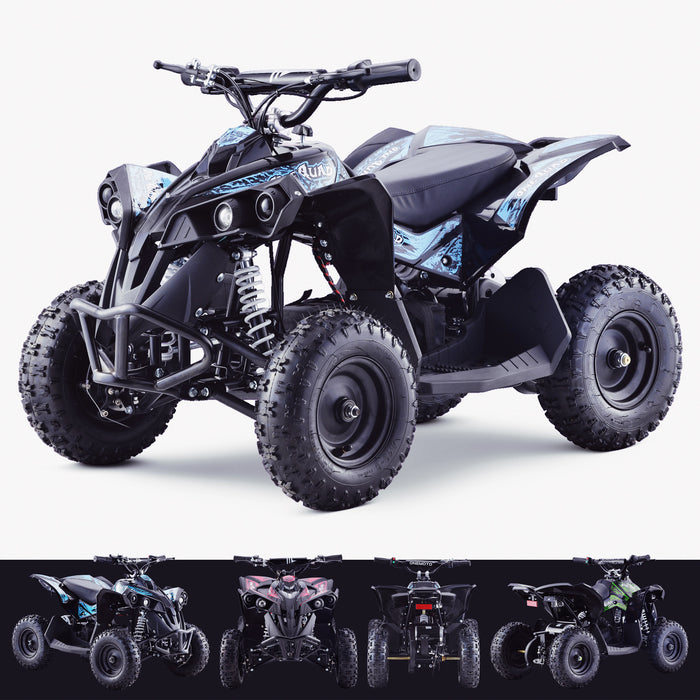
So, you're thinking about getting a quad bike?
That's great!
Quad bikes are not just fun to ride but can be super useful for a bunch of activities.
Whether you're planning to hit the trails for some adventure, need a hand around the farm, or just into the idea of zipping around your property, there's a lot to consider before making your pick.
Let's break it down into bite-sized pieces to make sure you find the perfect match for your needs.
Intended Use
Recreational Riding
If you're all about thrills and exploring trails, you're looking for something that can handle a bit of everything—from dirt roads to rugged terrain.
Think about the fun factor here!
Hunting/Fishing
Heading into the woods or planning to fish by a remote lake?
Your quad should have enough storage for gear and be stealthy enough to get you to your favourite spots without scaring away the wildlife.
Farming/Ranching
Need a workhorse? Then, it's all about durability and utility.
Your quad should be able to carry heavy loads, tow equipment, and handle whatever your day throws at it.
Determining the Primary Use to Guide the Selection Process
Honestly, identifying what you'll mostly use the quad for is half the battle.
It guides you through the rest of your choices, making sure you end up with a quad bike that's not just cool but useful for your specific needs.
Engine Size and Power
When you're browsing the quad bike market, you'll notice that engine size can vary significantly, and it's one of the most critical factors affecting a bike's performance, efficiency, and suitability for your intended use.
Range of Engine Sizes (Under 400cc to Over 1000cc)
Engine sizes for quad bikes start from under 400cc for lighter, more maneuverable models, and can go all the way up to over 1000cc for the power-hungry beasts designed for heavy-duty tasks and high-speed adventures.
Smaller engines are typically found in entry-level quads, suitable for beginners or those using them for light work tasks, easy trails, and recreational riding.
On the other hand, engines larger than 700cc are reserved for those who demand significant power output – whether for professional use in agriculture, competitive racing, or navigating challenging terrains.
Why Size Matters: The size of the engine directly impacts the quad bike's power, speed capabilities, and fuel consumption.
However, bigger engines also mean a heavier bike, which could affect maneuverability and the level of skill required to handle the bike safely.
Therefore, choosing the right engine size is less about finding the biggest one you can and more about matching the engine to your needs and riding ability.
Relationship Between Engine Size, Power, and Performance
Larger engines deliver more power – that's a given. They enable higher top speeds, more robust acceleration, and the ability to handle steep inclines or heavy loads with ease.
This makes them ideal for specific tasks like towing, competitive racing, or traversing rugged terrains.
However, this increased power comes with trade-offs in terms of fuel consumption and environmental impact.
Larger engines typically consume more fuel, increasing running costs and contributing more significantly to emissions.
Fuel Consumption and Efficiency: While it's tempting to opt for a larger engine for that extra power, it's essential to consider how much fuel the bike will use, especially if you're using it regularly.
Higher fuel consumption not only affects your wallet but also the environment.
Plus, in areas where fuel stations are sparse, a fuel-efficient engine could mean longer rides without the worry of running dry.
Balancing Needs and Power: The key is finding a balance between the power you need and the efficiency you desire.
For most recreational riders, mid-range engine sizes (around 400cc to 700cc) offer a good compromise between speed, power, and fuel efficiency.
These sizes are capable of handling most tasks and terrains the average rider will encounter, without the higher fuel consumption of the largest engines.
Fuel Consumption Considerations
Bigger engines gulp down more fuel. If you're conscious about your carbon footprint or just want to keep running costs low, consider this carefully.
Absolutely, let's flesh out those new sections to make sure your readers have all the info they need to make informed decisions about quad biking.
Environmental Considerations
When shopping for a quad bike, it's worth considering the environmental impact of your purchase.
Larger engines typically emit more pollution, so if you're eco-conscious, look for models with better fuel efficiency or even electric quad bikes.
These greener options not only reduce your carbon footprint but can also offer quieter operation, making them ideal for residential areas or peaceful outdoor experiences.
2-Wheel vs 4-Wheel Drive
Traction and Stability in Rough/Muddy Terrain
4WD (four-wheel drive) systems are engineered for maximum traction and stability across challenging terrains, making them indispensable for riders who frequently tackle mud, snow, and uneven ground.
The distribution of power to all four wheels prevents slipping and ensures a grip even in the slickest conditions, providing a safer and more controlled ride.
Cost and Fuel Consumption Differences
While the benefits of 4WD are clear in terms of performance, it's important to consider the trade-offs.
Quad bikes with 4WD are generally more expensive, both in upfront cost and maintenance.
They also tend to have higher fuel consumption due to the additional power required to drive all four wheels.
Before deciding, consider how often you'll actually need the capabilities of 4WD versus the ongoing costs.
Pros and Cons of Each Drive System
2WD quad bikes, offering power to either the rear or front wheels, are typically lighter, more fuel-efficient, and easier to handle.
This makes them ideal for recreational riding on flat or gently undulating terrains.
However, 4WD models provide essential additional traction and stability on challenging terrains but come with a higher price tag and operational costs.
The choice between 2WD and 4WD should be based on your typical riding terrain and requirements for traction and stability.
Suspension and Handling
Comfortable, Adjustable Suspension
Adjustable suspension systems allow riders to tweak the suspension settings based on the terrain's demands and personal comfort preferences.
This customisation can significantly enhance the riding experience on long journeys or when navigating particularly rough trails, ensuring that the ride remains comfortable and control is maintained.
Importance of Good Handling and Stability for Safety
Effective handling and stability are crucial for safely navigating through challenging terrains.
Quad bikes designed with a focus on handling can reduce the risk of accidents by ensuring that the vehicle responds predictably to rider inputs, even in difficult conditions.
This is not only about comfort but about minimising the risk of rollovers and loss of control.
Cargo Capacity and Towing
Cargo Bed Size
The size of the cargo bed determines how much gear, tools, or other essentials you can carry.
Larger beds are particularly useful for utility work or extended trips where you need to transport a lot of items.
Considering your typical load can help you choose a quad bike that meets your cargo carrying needs without compromising performance.
Towing Capacity
The ability to tow trailers or other loads expands the utility of quad bikes significantly.
Check the maximum towing capacity to ensure it aligns with your needs, whether that's hauling feed on a farm or bringing equipment to a remote campsite.
Matching the towing capacity with your requirements ensures you get the most out of your quad bike's capabilities.
Utility-Focused vs. Recreation-Focused Models
Utility models are designed with work in mind, offering larger cargo capacities, higher towing capabilities, and often more robust engines.
Recreation models prioritise speed, agility, and fun, perfect for those primarily interested in exploring trails or sport riding.
Identifying whether your interests lie more with practical applications or recreational activities can guide you toward the right type of quad bike.
Comfort and Ergonomics
Seat Height
Seat height affects both comfort and control, especially during long rides.
The right seat height allows you to easily reach the ground with your feet when stationary and maintain a comfortable posture while riding, enhancing control and reducing fatigue.
Foot Positioning
Proper foot positioning is essential for effective control and comfort.
Footpegs should be positioned so that you can easily operate the quad bike's controls while maintaining a relaxed stance, reducing strain on your legs and feet during extended periods of riding.
Adjustable Features (e.g., Handlebars)
The ability to adjust features like handlebars, seats, and footpegs allows you to customise the fit of your quad bike to your body, improving control and comfort.
This personalisation can make a significant difference in your overall riding experience, especially for those who spend long hours on their quad.
Ensuring a Comfortable Riding Experience
Ultimately, a comfortable riding experience is crucial for enjoying your quad bike to the fullest.
Look for models that offer the ergonomic features and adjustability you need to feel like the bike was made just for you, ensuring every ride is a pleasure.
Safety Features
Brakes
Effective braking systems are vital for safe quad biking, providing the stopping power needed in various conditions.
Look for quad bikes with reliable, responsive brakes that can handle the demands of your riding terrain and conditions.
Safety Nets/Doors
For those riding in rough terrains or at higher speeds, safety nets and doors can provide an additional layer of protection, helping to prevent injuries in the event of a rollover or collision.
Speed Limiters
Speed limiters can be a valuable safety feature, particularly for beginners or when letting children use the quad bike.
They allow you to control the maximum speed, reducing the risk of accidents caused by excessive speed.
Protective Gear (Helmets, Goggles, etc.)
Investing in high-quality protective gear, including helmets, goggles, and appropriate clothing, is essential for safe riding.
These items protect you from injuries and the elements, ensuring that you can enjoy your quad biking adventures safely.
Training and Licensing
Before you hit the trail or the field, make sure you're up to speed on any necessary training and licensing.
Some areas require a special license or safety course completion to legally operate a quad bike, especially on public lands or roads.
This training can be invaluable, teaching you essential safety practices and operation techniques to keep you and others safe.
Maintenance and Reliability
Maintenance Requirements
Nobody likes unexpected downtime. Look for quads known for reliability and easy maintenance.
Common Issues
Do your homework. Check out forums and reviews for any common issues with the models you're interested in.
Prioritising Reliability and Parts Availability
Choose a quad that won't leave you stranded. Reliable models with readily available parts can save you a lot of headaches.
Warranty and Service Plans
A good warranty and accessible service plans are your safety net for your quad bike.
They can protect against unexpected repair costs and ensure your bike stays in top condition.
When comparing options, consider the length of the warranty, what it covers, and whether extended service plans are available.
This can save you a lot of hassle and money in the long run.
Brand Reputation and Retailer Support
Choosing a Reputable Brand
Stick with brands known for quality and reliability. It's worth it in the long run.
Importance of a Strong Dealer Network
Having a dealer you can count on for service and support is priceless, especially when you need parts or repairs.
Access to Service, Parts, and Accessories
Make sure you're not going to struggle to find parts or services. A good dealer network means less hassle for you.
Community and Support Forums
Joining a community or support forum for quad bike enthusiasts can be incredibly rewarding.
These platforms are goldmines of information, from troubleshooting mechanical issues to finding the best riding spots.
They're also great places to connect with fellow riders and share experiences.
Before buying a bike, check out if there's a robust community for the brand or model you're interested in; it could make all the difference in your riding experience.
Legal Considerations
Licensing Requirements
Depending on where you live, you might need a specific license to operate your quad bike, especially if you plan to use it on public roads or areas.
Check your local laws to ensure you meet all legal requirements, which might include age restrictions, safety gear mandates, and even vehicle inspections.
Registration and Insurance
Just like any vehicle, your quad bike may need to be registered, and you'll likely need insurance to ride legally and safely.
Insurance can cover everything from damage to the bike, liability for injury or damage to others, and theft.
Taking care of these legal necessities upfront can save you from hefty fines or worse, should you ever have an accident.
Test Riding a Quad Bike
What to Look For
Test riding a quad bike is crucial before making a purchase.
Pay attention to how the bike feels under you. Is it comfortable?
Can you reach all the controls easily?
How does it handle turns and rough terrain?
Make a mental note of anything that feels off or uncomfortable, as these could become significant issues down the line.
Making the Most Out of a Test Ride
To truly make the most of a test ride, plan ahead. Bring the gear you would typically wear while riding, and if possible, test the bike in conditions similar to where you'll most often use it.
Ask the dealer if you can try different models to compare, and don't rush the process.
A test ride should give you a clear sense of whether a bike is right for you, so take your time to ensure you're making the right decision.
Budget and Financing
Purchasing a quad bike is an exciting venture, but it's also a significant investment.
Understanding the financial implications, from the initial purchase price to ongoing costs, is crucial in making a decision that aligns with your budget and lifestyle.
Range of Purchase Prices
The price of quad bikes can range significantly based on factors like brand, engine size, features, and whether you're buying new or used.
Entry-level models might be available for a few thousand dollars, while high-end, feature-rich models could set you back tens of thousands.
Setting a clear budget from the outset helps narrow down your options and keeps your search focused on what you can afford.
Remember, the most expensive option isn't always the best fit for your needs.
Exploring Financing Options
For many, purchasing a quad bike outright might not be financially feasible.
Fortunately, there are financing options available, such as loans or payment plans offered by dealerships.
When exploring financing, it's essential to understand the interest rates, repayment terms, and any potential fees involved.
Financing can make owning a quad bike more accessible, but you'll need to ensure the monthly payments fit comfortably within your budget to avoid financial strain.
Factoring in Ongoing Costs (Insurance, Fuel, Maintenance)
Beyond the sticker price, the total cost of ownership includes insurance, fuel, maintenance, and potentially storage.
Insurance costs can vary based on the type of quad bike, how it's used, and the rider's profile.
Fuel expenses will depend on how often and how far you ride, while maintenance costs can be influenced by the model's reliability and how well you take care of the bike.
Regular maintenance is crucial in prolonging the life of your quad bike and can save money in the long run by avoiding major repairs.
It's wise to estimate these ongoing costs beforehand to get a realistic picture of the total investment required.
Making an Informed Decision
When considering a quad bike purchase, the key is to look beyond the initial price tag and evaluate the total cost of ownership.
A budget-friendly option might end up costing more over time due to higher fuel consumption, frequent maintenance, or expensive insurance.
Conversely, investing a bit more upfront for a reliable, fuel-efficient model could save money and hassle in the long run.
Before making a decision, take the time to research, compare different models and financing options, and consider all associated costs.
This comprehensive approach ensures that when you do make your purchase, you're not only choosing a quad bike that fits your lifestyle and preferences but also one that aligns with your financial situation.
Get in Touch 🚀
Loved our article on “What to Consider When You're in the Market for a Quad Bike” Got the itch to dive into more wheely-awesome info?
Whether you're a parent or a grandparent, we're here for all your kids ride-on toy questions! 🚗💨
Feeling click-happy?
Jump straight into our wonderland at RiiRoo.com.
Or, if you're more the chatty type, give our Live Chat a whirl and let's talk toys!








Share:
How To Secure Your Quad Bike The Right Way
Here's How To Pick The Right Scooter Size